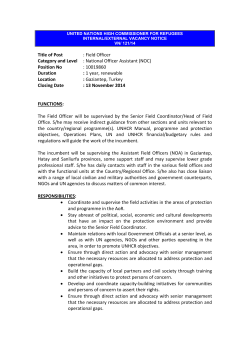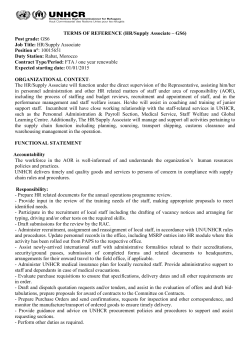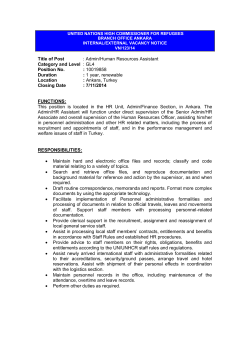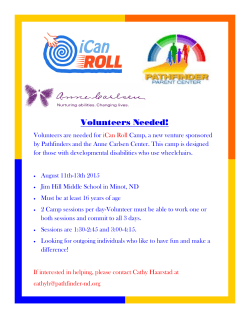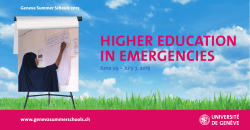
HIGHLIGHTS
DJIBOUTI INTER-AGENCY UPDATE FOR THE RESPONSE TO THE YEMENI CRISIS 7 May – 13 May 2015 KEY FIGURES 1,145 HIGHLIGHTS UNHCR and ONARS, the government refugee agency, have registered 1,145 arrivals from Yemen since 27 March. Of these, 867 refugees are currently hosted in the temporary transit center Al-Rahma orphanage and at the Markazi camp. UNHCR has continued the distribution of refugee attestations at the Markazi camp. Until 12 May 260 refugees have received ID-cards. UNHCR has established a presence at the port in Obock and started its border monitoring activities on the ground. IOM Djibouti has assisted 204 TCNs with visa support, transfer, transit accommodation, and onward air and ground transportation Refugees registered since the outbreak of the crisis. 260 ID-cards distributed. 399 Registered children and adolescents. 204 Population of concern TCN assited. A total of 1,145 people of concern Nationality 0-4 years PRIORITIES Ensure protection of refugees and provide assistance. Provide documents to refugees Work with the government to ensure registration of newly arrived refugees. Continue to develop the infrastructure at the Markazi camp. Continue border monitoring activities. Yemen Syria Irak Palestine Somalia Eritrea Pakistan Total M 50 0 0 0 0 3 0 53 F 5-11 years 55 M 79 0 0 0 0 0 1 56 0 0 1 3 0 0 83 F 12-17 years 68 M 64 0 0 0 5 0 0 73 0 0 0 0 2 0 66 F 18-59 years 60 years+ 65 M 421 F 227 M 33 0 0 1 1 1 0 68 4 1 1 5 5 1 437 0 0 2 6 1 2 238 0 0 0 0 0 0 33 TOTAL F 36 1098 0 0 0 2 0 0 38 4 1 5 22 12 4 1145 1 Inter-Agency Update-Yemen Situation Djibouti UPDATE ON ACHIEVEMENTS Operational Context Since the escalation of the Yemen conflict in March 2015, more than 1,200 people were killed and over 5,000 injured, including a large number of civilians. At least 150,000 people have been displaced, food prices have risen by more than 40% in some locations and fuel prices have quadrupled. The country’s health system is at imminent risk of collapse due to shortages of medical supplies and fuel for generators. In this context, those Yemenis, refugees, migrants and TCNs with means to leave Yemen flee the country to the neighbouring countries. According to statistics from IOM and the Djiboutian government, 11,183 persons of mixed nationalities have arrived in Djibouti as of 12 May since the onset of the crisis. 4,265 of those are Yemeni nationals. As of 15 May UNHCR has registered 1,218 refugees of which 1,170 are Yemeni nationals. In order to be able to host the new arrivals, the government has asked UNHCR to establish a new refugee camp in Obock, a region in the North of Djibouti. The refugee site, Markazi, is located on the coast, four kilometers away from Obock city, the capital of the region. 940 refugees are currently hosted in the temporary transit center Al-Rahma orphanage and at the Markazi refugee camp. The overall living conditions in Obock are difficult. Obock is a hard-to-reach region that has been severely affected by drought since 2008. Considering the influx of populations from Yemen and the consecutive decision to setup a new refugee camp, its consequences on the host communities have to be considered. Djibouti has a long tradition as a refugee-hosting nation. Despite its limited resources, the country has always hosted thousands of people in search of security. For decades, the Republic of Djibouti has been hosting a caseload of refugees from neighbouring countries (Somalia, Ethiopia and Eritrea) who have fled war and political conflict in the unstable part of the Horn of Africa region. Achievements Protection Achievements and Impact UNHCR and ONARS have registered 203 refugees during this reporting period. 140 family attestations and 280 IDCards for refugees have been distributed. For protection and safety purposes, ONARS has installed a generator with a capacity of 20 KVA at Markazi camp. The capacity of the generator allows lighting of areas in the camp from 07:00 p.m. until 03:00 a.m. Negotiations are under way for a generator with a bigger capacity as well as for charging stations and power extension cables. One separated child and two unaccompanied children have been identified by UNHCR Community Services staff. They are currently staying at Markazi camp. A Best Interest Assessment has been conducted. While the two unaccompanied children are under the guardianship of the community leader, the separated child stays with his uncle. Yemeni refugees at Markazi camp who just have received their family attestation and ID-cards. © UNHCR The questionnaire on Child Protection rapid assessment was discussed and validated by the Protection Working Group. The methodological approach is being developed and the assessment will be launched at the end of May by UNICEF and UNHCR in partnership with DRC, UNFD and the Association for the Promotion of Children Rights. Identified Needs and Remaining Gaps United Nations High Commissioner for Refugees (UNHCR) – www.unhcr.org 2 Inter-Agency Update-Yemen Situation Djibouti There is an urgent need of the enclosure of the camp in order to ensure a maximum of security to refugees living in the camp. This concern has been raised several times by refugees who confirmed not feeling safe in the camp as trespassers and animals could easily enter the site. UNHCR did an assessment on the enclosure of the camp which amounted from USD 304,000 to USD 467,000. UNHCR is advocating for reinforcement of the security personnel in the camp, in order to ensure safety on the site as well as access to the water bladders and prevent vandalism on the infrastructure. Once in place, UNHCR will organize training sessions / awareness raising campaigns amongst security staff specific to the refugee camp context. There is a need for strong generators (100 KVA) to provide public lighting for the entire camp site which would increase the feeling of security in the camp. As far as departures from Obock are concerned, the movement from Obock to Djibouti and from Obock to Yemen remains a serious concern to UNHCR, even if the nature and scope of the reasons of leaving are difficult to ascertain. Notwithstanding, UNHCR’s counselling at the border outlining the risk they might face in case of return, 14 individuals (males) originating from Yemen reached the port of Obock and made their final decision to go to Yemen. They were very reluctant to share basic information with UNHCR. The local authorities facilitated their travel following an agreement not to take any action against their will to join their families reported to be still in Yemen. Refugees in Obock are yet to understand the extent of the rights and duties they are accorded by their refugee status. In this context, all efforts to facilitate common understanding will be encouraged. This should be done jointly with the government and the community leaders. As a first step an information brochure will be developed and distributed by UNHCR. Migrants, TNC, returnees Achievements and Impact As of 11 May, IOM Djibouti has assisted 204 TCNs with visa support, transfer, transit accommodation, and onward air and ground transportation. Until 13 May, 311 Ethiopians who were stranded in Djibouti were provided with evacuation assistance to Addis Ababa. Education Achievements and Impact UNHCR conducted a preliminary education assessment for the Yemeni caseload that will be settled in Markazi camp, and met with local authorities and education inspectors. Additionally, UNHCR conducted a partner mapping exercise locally and met with UNICEF about the deployment of EiE tents and materials. UNICEF has prepositioned 2 tents, 2 school-in-a-box with Early Childhood Education pedagogical materials for about 100 children during three months. A summary of the assessment and a preliminary plan will be presented to partners during the Education Sector Working Group meeting for discussion, revision and validation. Health Achievements and Impact Waiting for a full-fledged presence of a medical partner, UNHCR and the local authorities are handling serious and daily medical cases on a case-by-case basis with a potential referral system to the existing medical infrastructure United Nations High Commissioner for Refugees (UNHCR) – www.unhcr.org 3 Inter-Agency Update-Yemen Situation Djibouti in Djibouti ville. Refugees with specific medical conditions / chronic diseases have been identified and were given priority along with the elderly refugees, who cannot stand the heat. Thus, an evacuation system has been established to provide timely and proper assistance when needed. An integrated national vaccination campaign against Polio and Measles has been launched by the government with the support of WHO. The campaign is targeting children until the age of 15 years. WHO officals visited Markazi camp to assess the needs and advocated for the inclusion of the refugee population. Vitamin A supplementation and check-up of immunisation status is ongoing for all under-5 refugee children upon arrival. WHO provided five mobiles clinics to the Ministry of Health with support of Government of Japan with an approximate cost of USD 400,000. One mobile will be dedicated to the region of Obock, where it will also be at the service of refugees. The mobile clinics provide amongst others basic preventive and curative health care such as consultations for pregnant women, vaccination, detection and management of malaria, diarrhoea, HIV testing. Identified Needs and Remaining Gaps Given the high vulnerability of the refugee population, especially children and women, it is critical to ensure the continuity and quality of healthcare services. Food Security and Nutrition Achievements and Impact Malnutrition screening is ongoing for all under-5 refugee children, pregnant women and lactating mothers upon arrival. Six cases of severe acute malnutrition and 12 cases of moderate acute malnutrition have been identified among children under-five, and are receiving adequate treatment and care. The medical status of the two children suffering from severe acute malnutrition who had been admitted at Obock Regional Hospital for paediatric care last week is now stable. They are back to the Markazi camp and are now taken in charge by the medical service in site. As of 17 May, the World Food Programme provided food assistance to 974 refugees at Markazi camp and in the temporary transit center Al-Rahma. During the reporting period, WFP distributed dry food rations for the coming two weeks to more than 300 Yemeni refugees in the camp. The food rations comprise of wheat, peas, oil, sugar and Wheat Soya Blend. Hangar for food distribution at Markazi camp, Obock. © UNHCR Identified Needs and Remaining Gaps Notwithstanding the referral system of refugees with specific medical needs and their regular follow up with the doctors, there is a need to develop a feeding program with other partners most importantly for cases suffering from Diabetics and High blood pressure. In this regard, the provision of specialized menus for these particular cases will be discussed with ONARS. United Nations High Commissioner for Refugees (UNHCR) – www.unhcr.org 4 Inter-Agency Update-Yemen Situation Djibouti Water and Sanitation Identified Needs and Remaining Gaps The presence of several humanitarian actors in the field is key for the response but also poses risks in terms of duplication of interventions, particularly when it comes to distribution of WASH NFIs. Shelter and NFIs Achievements and Impact Refugees who have been hosted in the transit center situated in the sports center have all been transferred to Markazi camp. In order to provide shelter to the new arrivals, UNHCR has erected 25 additional tents which lead to a total of 124 tents at camp site. 90 additional tents are expected to arrive in the coming days and will be installed in the camp. Refugees staying at the Al-Rahma transit center are expected to move progressively to the camp. Identified Needs and Remaining Gaps At the Markazi camp site, 40 latrines and 10 community kitchens are currently in place. 34 latrines are still subject to additional work and adaptations in order to meet UNHCR emergency standards. Working in partnership UNHCR is coordinating assistance efforts with the government. The response is organized per sectorial working groups (for protection, shelter, water, food security, nutrition, education and health). These sectorial activities are included in the contingency/response plan to ensure a harmonized approach between all cooperating NGOs (NRC, DRC, AHA, LWF…), UN agencies (UNICEF, WFP, FAO, WHO…) and governmental counterparts (ONARS and different ministries). 11 UN agencies and NGOs have submitted their inputs for the Refugee Response Plan for the Yemen crisis. A first draft has been sent to all organizations involved for feedback and comments. The amended document was shared with participating organizations at headquarter level and is currently circulating for further comments. FINANCIAL INFORMATION Agencies are very grateful for the financial support provided by donors who have contributed to their activities with unearmarked and broadly earmarked funds as well as for those who have contributed directly to the operation. Contacts: Marie-Claire Sowinetz, External Relations Officer, sowinetz@unhcr.org, Cell +253 77 20 23 26 Links: Twitter: @UNHCRDjibouti Regional portal: http://unhcr-regional.or.ke/country/djibouti United Nations High Commissioner for Refugees (UNHCR) – www.unhcr.org 5
© Copyright 2025
